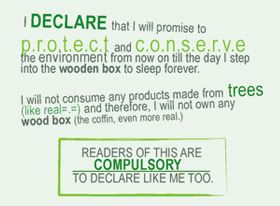










 credits:http://visual.merriam-webster.com/images/earth/environment/land-pollution.jpg
credits:http://visual.merriam-webster.com/images/earth/environment/land-pollution.jpgA very long time ago, at the beginning of the twentieth century, William T. Love imagined a model community in New York, on the edge of Niagara Falls.
::Niagara Falls:: by ~tikimiku on deviantART
Love dug a canal to supply water power to what he envisioned would be a combination of industrial and residential areas in his community. It was meant to be a dream community. Unfortunately, Love was unable to complete his project.
During the 1920s the canal he dug was turned into a landfill operated by the Hooker Chemical Company.
In 1953, Hooker sold the site to the Niagara Falls Board of Education for $1, with the disclaimer ". . . that the premises above described have been filled . . . to the present grade level thereof with waste products resulting from the manufacturing of chemicals. . . ."
The city built an elementary school on the site. Houses were later added. Over the years, the underground containers filled with approximately 21,000 tons of chemical waste corroded.
In 1977 a record rainfall brought about a tragic consequence: The waste began to leach into people's homes, backyards, and playgrounds.
Love's Canal has been officially associated with high rates of birth defects, miscarriages, and other severe illness resulting from land contamination. In short, he was the culprit in everyone's eyes.
The tragedy of Love Canal is perhaps the most famous incident of chemical waste dumps that are harming people, but it is definitely not the only one. Health effects range from cancer to birth defects. However, the practice of chemical dumping persisted for years in the early twentieth century, in many places, without any thoughts to the possible risks or consequences of these actions.
When the Love Canal leached its deadly contents, the United States began to take notice.
In 1980 Congress enacted the Comprehensive Environmental Response, Compensation and Liability Act (CERCLA), the first U.S. federal law to address toxic waste dumps. CERCLA, also known as Superfund, is the emergency fund to clean toxic waste dumps when the owners of the dumps are unknown or unable to pay for a necessary cleanup.
While Superfund is helping to clean up many hazardous sites, litigation over liability led to delay and costly legal battles over who pays for cleanups. Another criticism is that Superfund lacks clear standards as to what constitutes a "clean" site. 
Across the globe, developing countries have been buying hazardous waste from developed nations, where disposal is more expensive. Historically, there has been little or no law at all to control the disposal of hazardous waste; as the world becomes more of a global community, however, this problem will no doubt haunt future generations.
Isn't the future generations: us?
Give me Liberty. I've Already Got Death.(From a sign displayed by a Love Canal resident, 1978)
Environmentalist Blogged:4:28 PM




